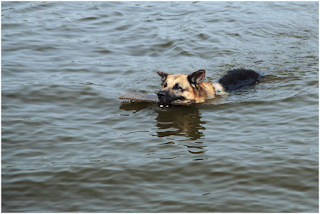Toxic Algae: Is it safe for my dogs to swim?
On a beautiful sunny August day, three dogs named Abby, Harpo, and Lizzy went for a swim at a pond in Wilmington, North Carolina. They were happy and healthy pups. And by the days’ end, all three were gone. The cause: toxic algae.
It sounds like a scene from The Blob or straight out of your worst nightmares. How can something as benign as a swim in a lake turn deadly? Sadly, these tragic stories are popping up in the news from the Pacific Northwest all the way down to the far reaches of the southeast. The good news is, knowledge is power. You can avoid these potentially devastating situations by being aware of your pet’s surroundings. Information is hard to find and often confusing, even for a veterinarian- so I put some information together that I hope you will find helpful. Here’s what all dog owners need to know about toxic algae blooms:
What is toxic algae?
Blooms of blue-green algae derive from small bacteria called cyanobacteria. In large numbers, these bacteria aggregate to resemble a greenish sludge on the surface of bodies of water. While the current blue-green algae blooms in the news are associated with lakes and ponds, algae blooms occur worldwide in all types of bodies of water. Some, but not all, forms of these algae produce deadly toxins. These blooms are called Harmful Algal Blooms (HAB).
Why is this happening so much lately?
While toxic blooms are nothing new, they do happen more frequently in the hot, sunny days of summer and fall. Summer rainstorms also dump nutrient-rich runoff into bodies of water, fueling the algae’s growth. Slow-moving water is more likely to experience blooms, hence the increased incidence in ponds and lakes versus oceans and rivers.
Do toxic blooms only affect dogs?
No, the toxic effects of HABs can affect many animals. We see these incidents most commonly in dogs because they spend more time swimming than other pets. In addition, they often swallow water while they are swimming and are more likely to ingest a toxic dose.
These toxins can cause illness in people, birds, and other wildlife. In addition, the toxins can be absorbed by fish and shellfish, causing a chain reaction in the food supply. A 2015 outbreak on the West Coast decimated fisheries, causing die-offs of fish and shellfish from Alaska all the way down the California coast.
What are the effects of the toxins?
When a dog swallows water with algal toxins or grooms the algae off his fur, the effects can be seen in minutes to hours. Algae produce different types of toxins that affect the liver, GI tract, and neurologic system. With liver disease, clinical signs start in minutes to hours and include vomiting, diarrhea, jaundice, seizures, and weakness. With neurotoxins, pets can also fall ill in minutes to hours. Affected animals produce excessive saliva, experience tremors, have difficulty breathing, seizures, or collapse. Both types are deadly. Even touching toxic algae can cause skin irritation or respiratory inflammation.
Regardless of the specific toxin, any of these symptoms after swimming in a lake should be considered a medical emergency. There is no known antidote to the toxin. Your veterinarian can provide supportive care and treat the symptoms, but sadly many dogs succumb to the illness.
How do I know if a lake or pond is experiencing a HAB? Is all algae toxic?
Not all algae produces deadly toxins. In fact, most do not. That’s the good news. The bad news is, one cannot tell simply by looking whether an algal bloom is toxic or not. Blooms often produce a greenish scum on the surface of the water, but can appear brown as well. Sometimes there is no mat on the surface at all and the water simply has a greenish tint. If you see water that looks like this, don’t take chances. Keep yourself and your pets away unless you have specifically been given the green light by your local municipality.
According to the CDC, the following warning signs indicate a body of water that is potentially unsafe:
Avoid entering or playing in bodies of water that: smell bad look discolored have foam, scum, or algal mats on the surface contain or are near dead fish or other dead animals (for example, do not enter a body of water if dead fish have washed up on its shore or beach)
Is there an agency that monitors water safety?
Suspect water can be tested to determine whether toxins are present in the water. Just because the water in one lake is deemed safe, it doesn’t mean the lake a few miles away is also safe.
To reiterate: these blooms are found across the globe, in lakes, ponds, and oceans. Your county or state health department is usually your best resource for finding out the current status in your area. Some states list “HAB Incident Reports” indicating harmful algal blooms in the region, such as this site maintained by the California Water Quality Monitoring Council.
A last word of caution: In an era of tightening budgets, routine monitoring is not the standard in many places and testing may not occur until after a problem is noted.
When in doubt, just stay out!


